
It’s acorn season in Southern California. I’ve long been interested in acorns, knowing that they were the staple food of the native people who lived here, and I’ve gathered and processed them before. However, once I have the acorn meal, I’ve never known exactly what to do with it. It’s highly nutritious, but I thought (wrongly!) that it was somewhat bland, and all I could do was incorporate acorn meal into baked goods. This weekend, however, I’ve had my eyes opened to the possibilities, thanks to Pascal Baudar and Mia Wasilevich.

Pascal and Mia putting out a spread: acorn sliders, acorn and tapioca pudding, red cabbage and red onion slaw with wild juniper berries, chocolate truffles infused with white sage and dusted with dehydrated raspberry powder, plum membrillo and beer hopped with yarrow. We were there to learn about acorns, but they fed us well!
Pascal and Mia are high caliber foragers and foodies. Check out their sites, Urban Outdoor Skills and Transitional Gastronomy, and if you live in the Los Angeles area, you’ll definitely want to experience their forages and food workshops.
It’s rare to find folks who combine deep food know-how with a love of wild foods. Too often wild foods are considered mere survival foods. Pascal and Mia are using them to develop a uniquely Californian cuisine.
On Sunday, Erik and I attended their acorn processing workshop, where we learned some valuable tips regarding acorn processing, and were privileged to eat the finest vegetarian burgers we’ve ever tasted — sliders made with acorns.

I’ve downed a lot of veggie burgers in my time, and I’ve come to think of them mostly as excuse to eat bread and condiments. I’ve never had a veggie burger good enough to eat on its own. The acorn burgers they treated us to were not just “good for veggie” but some of the tastiest food I’ve ever encountered.
It turns out that acorns have umami qualities, that savoriness that characterizes meat and mushrooms, along with a delicate sweetness. You just need to know how to bring it out.
Mia did say that acorns have unique qualities in how they hold and absorb moisture, so she’s been learning how to handle them. Like any new food, it takes a while to learn the ways of acorns, but it’s worth it.
On this pdf you’ll find Mia’s recipe for acorn timbales. If you serve these on a bun, instead of in a pool of (amazing looking!) nettle veloute sauce, you will have the acorn burger I experienced this weekend. Do be sure to note the part where she asks you to refrigerate the mix before cooking. She told us that if the mix doesn’t have time to set up, the patties will fall apart. The recipe doesn’t specify how long to chill, but I believe she said overnight. (You could also make a log of the mix and freeze it for later, like cookies.)
I’m going to forage some acorns of my own this week and see if I can replicate those sliders. In the meanwhile, after the jump I’m going to share some processing tips that I picked up.
Let us know if any of you process acorns, and if you have any tips or recipes!
Harvesting Acorns
Pascal explained to us that acorn trees don’t bear full crops every year, so you have to keep your eyes open, and scout around to find trees which are in full production. All acorns are edible, they simple vary by size and tannin content. Tannins in the acorns make them bitter, and inedible unless the tannins are leached out. (Theoretically you could ruin your kidneys by eating unprocessed acorns, but the tannins make them so nasty that you’d be hard pressed to eat enough to do yourself harm.)
So find yourself a tree which is bearing and pick up the acorns on the ground beneath it. You will probably come to favor acorns from certain types of oaks more than others, but anything you find can be made useful. As you gather, inspect each acorn for tiny holes in the shells. That means weevils have got into them. Discard those.
Apparently, squirrels have the ability to know which acorns are more “buggy” and leave those behind. You are in competition with the squirrels for the good stuff, so the sooner you harvest, the better.
You do not want to pick green acorns off the tree, but if you find green acorns on the ground, go ahead and pick those up too. Then put them in the sun for a day or so, and they’ll turn brown.
Acorn Storage
Keep your stash in mesh bags until you’re ready to use them. If you leave them in plastic they’ll get moldy. Acorns high in tannins keep longer than those low in tannins, and may be less palatable to insects. So those are best for storage. Meanwhile, sweeter acorns don’t keep as long and should be used sooner. Around here, a good example of sweet acorns are the big fat acorns from white oaks, while the most bitter are the skinny, pointy acorns from interior live oaks.
Even before storing the acorns in mesh bags, you might want to spread them out somewhere and let them dry a bit, just to be safe– ideally on a screen, but you could also spread them on the floor of the garage. You’d make the call depending on how soon you are planning to use them, and how humid your climate is, and how humid the storage area is.
You should be aware that acorn weevil larvae will likely emerge, from time to time, from any collection of acorns., especially the fresher ones. (Older acorns may have acorn moths in them, though. These moths move into the holes left behind by the weevils. Nature is beautiful that way.) They are harmless to you, pets, carpets and furniture. They are edible, even tasty, I hear. If they end up in your house they’ll probably dehydrating to death quietly under your couch or behind a bookshelf, or perhaps will be batted to death by inquisitive cats. At any rate, if you don’t want larvae in your house, you’ll want to keep the acorns somewhere else.
Acorn Processing
No matter what type of acorn you’ve harvested, you’ll need to leach the tannins out with water. This is a faster job with sweeter acorns and a longer job with the more bitter ones. But either way, you’ll have acorn meal at the end. To start the leaching process, you’ll need to shell the acorns and chop them up first.
Note: If you’ve harvested different types of acorns you might want to consider separating them out by type and leaching each type individually, since leaching time can vary so much between types.
Shelling the acorns
This is the most time consuming part of the process, and like any type of food processing, is the most fun if you can do it with a buddy or two. Hold an acorn party!
You can hit whack acorns on the pointy end with a rock or hammer. I’ve also cracked and peeled acorns with pliers in the past, but Pascal turned me on to his knife method. You’ll need a very sharp knife and an old kitchen towel. Fold the towel in half and put it on the cutting board. It will stop the acorns from skittering around and save you from accidental cuts. Then carefully chop each acorn in half, across the short side, and then cut the halves into quarters, then you can easily pick out the meat. Be sure to lift your fingers up before you bear down with your weight on each cut to keep your fingers far away from the blade.

You will run into insect damage fairly frequently, and less frequently, actual insects: the larvae that the beetles plant in the acorns. You can see some typical damage in one of the acorns above. If you find a grub, consider Pascal’s solution–cook ’em up and eat ’em! Otherwise, any wormy, moldy or discolored bits can be trimmed away from otherwise clean nut meats.
Note that fresher acorns are more difficult to shell than dryer acorns. So if you find you’re having lots of trouble, let the acorns dry out for a week or two and see if it doesn’t get easier.
Also, note that the acorn meats oxidize after they spend some time in the air, so if you want to keep the meats pale, toss them in a bowl water as you shell them.
Consider how you plan to use your shelled acorns
At this point you need to pause and make a decision about how you plan to use your acorns. There are two types of leaching: hot and cold, and which one you choose depends on how you plan to use the acorns.
You use cold water leaching to make acorn meal suitable for baking. The cold water preserves the starchiness of the acorn meal, which makes it work well in breads and pancakes and muffins and such.
Hot water leaching removes the starch, but seems to bring out the nutty flavor more, which makes it better for using the acorns in savory foods, like acorn burgers, or, Pascal says, in sauces. He and Mia have concocted acorn sauces to serve with game, which sounds wonderful. Basically, it seems like this process is the best way to go if you plan to use the acorns as nuts. It seems like you could substitute them for recipes which call for hazelnuts. The pudding Mia served us, for instance, was a tapioca pudding in which the the cream was first infused with acorns, and acorn meats were folded into the pudding.
You can also choose to store the meats at this point, unleached. You can dry the meats out in a dehydrator or low oven, then put them in a container until you need them. At that point you will want to soak them to soften them up for grinding.
Cold Water Leaching
Again, this is what you do if you want to bake with your acorns, if you want the starch in them. An added advantage of this process is that it keeps the acorns pale, so your flour is pale, which can be nice, depending on what you’re baking. Heat processing makes the acorns sort of mushroom colored.
The first step is to chop or grind your acorns into small pieces to make the leaching faster. You don’t want to try to leach whole acorns. If you have a sausage grinder, this works very well. Another tool which works well is a metate (a course mortar and pestle). Food processors tend to make the acorns into paste, so aren’t recommended. You can also just chop them up fine by rocking a big knife over them. However you go about it, in the end you should have a coarse meal.
Line a colander with two layers of cheese cloth, pour in the acorn meal, and set the colander over a large bowl, place it in a sink, and fill it with water. I’ve leached acorns by placing the colander in a bowl of fresh water, then walking away for a while, and coming back and changing the water every so often. It gets cloudy with tannins, and I just kept filling, soaking and changing until the water became clear. It was sort of a day long project. Pascal does not let them soak. He just fills the bowl up with water, then dumps it out immediately, doing this perhaps 20 times in row. He claims it takes about a half hour or so.
Either way, keep rinsing until the meal loses its bitter taste. The taste of tannins is quite distinctive. They are not only bitter, but they sort of pickle your tongue. When this is gone, you’re done.
If you want to make flour out of the meal, dry it out thoroughly in a low oven or dehydrator, then put it in a food processor or similar.
Hot Water Leaching
In this method you boil the the quartered acorns from the first round of processing. Grinding isn’t necessary here, and preserves the acorn meats for uses that require pieces rather than meal.
Put the acorns in a pot with plenty of fresh water. You could/should add some salt. Bring them to a boil and let them simmer for 20 minutes or so. As they cook, they’ll shed their skins. The skins are bitter, so skim those off the surface as they rise. After 20 minutes drain the acorns and taste them. The sweetest ones may only require one round of boiling, but more than likely they’ll still be bitter, so will need additional rounds. I did a test batch with moderately bitter acorns and boiled them for 5 rounds. Allow plenty of time for this process.
This is important: Do not add cold water to the acorns after the first round of boiling. Instead, add boiling water to the pot to start the next round of simmering. Adding cold water to the hot acorns locks in their bitterness in somehow, ruining all your effort. Add more salt if you want and boil for another 20 minute interval. Rinse and repeat until the bitterness is gone.
If you are working with acorn quarters, check the chunks once they’ve cooled to be sure all the skins have come off. If not, pick them off. Or, once the chunks are dry, rub them between your hands to remove the skins, as you would with hazelnuts.
After this, you can chop or grind the pieces up to use in acorn burgers.
An aside
At this point you might be thinking that this is an awful amount of work for dinner, but I’ve realized its a heck of a lot easier than growing, harvesting and threshing wheat. High value carbs don’t come out of nowhere–but they do grow on trees!
Last steps
Now you’re ready to cook with your acorn meal. It’s wet, so if you’re not going to use it immediately, I’d recommend drying it. You can spread it on cookie sheets and dry it in a very low oven, stirring frequently to get the wet stuff exposed to the air. Or if you have a dehydrator, you’re set. You could also freeze it (or dry it and then freeze it), or if you are going to cook with it with a couple of days, keep in the fridge. Same goes for the meats if you keep them intact.

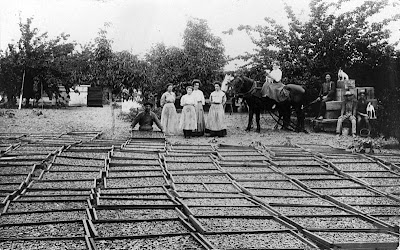
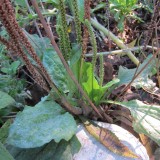
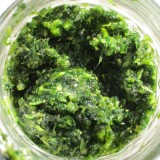
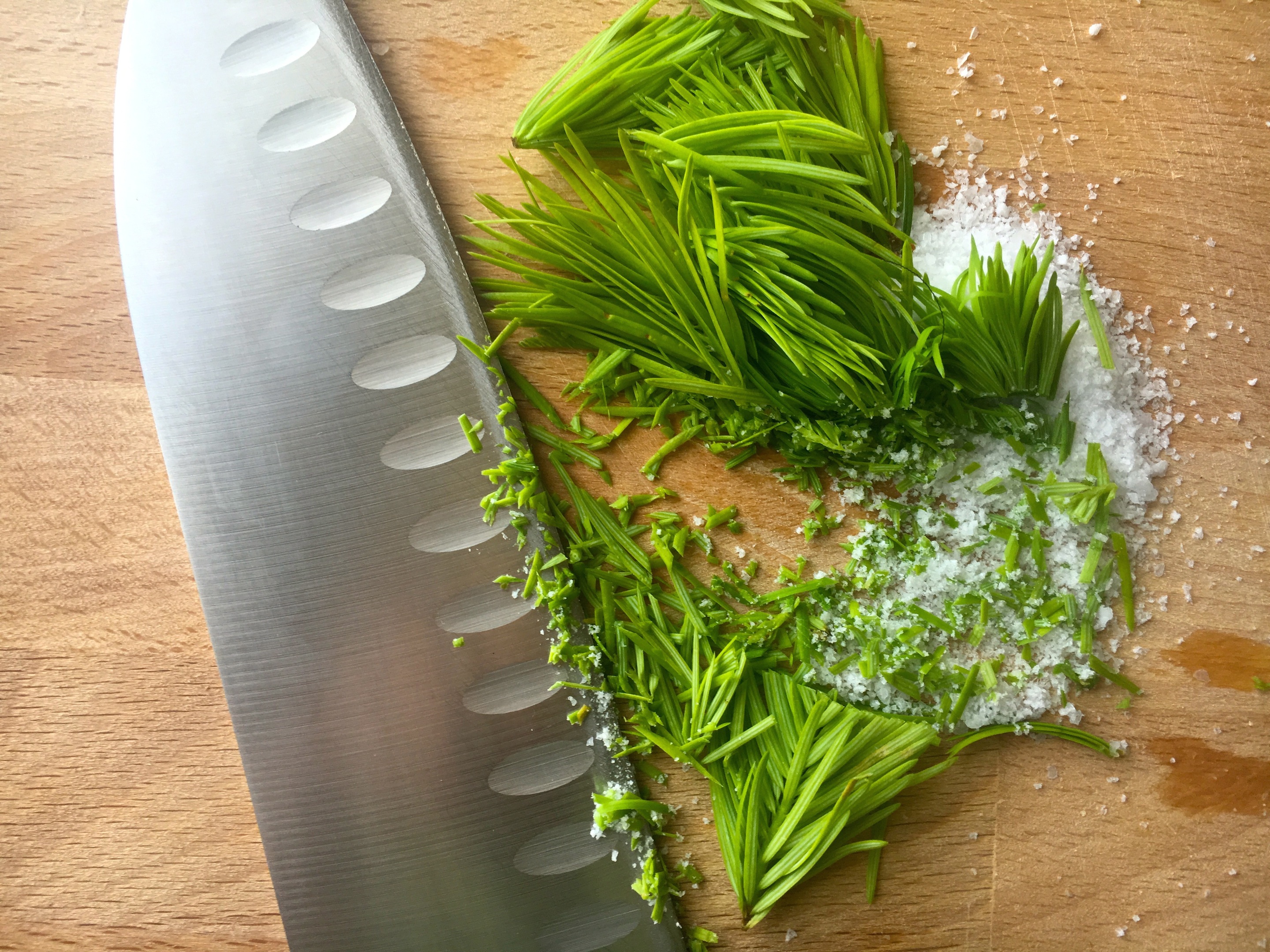
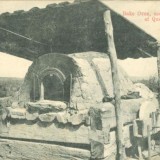
Amazingly, I just posted the puny acorns that fall in my yard from Water Oaks. If you look, you can see they are not even a half inch across. I have two huge trees of these. Can they be used? Someone said they were bitter. I wish someone had planted Stuart pecans!
Acorn burgers on white bread along with Transitional Gastronomy? White bread? It made me smile.
An acorn is an acorn and all of them can be used. I guess the primary problem with tiny acorns would be shelling them–it would be a whole lot of work–and not a lot of bang for the buck. As far as bitterness goes, any level of bitterness can be leached out, with work.
I have to admit the white bread buns were really pleasing–we’ve been eating nothing but stern sourdough rye around here!
This is such a neat article! I live in a region with lots of oak trees. I’ve always wondered how it was possible to eat acorns – when I tried little nibbles as a girl, I had to spit it out. Book marked your article and might give it a try next autumn (we’re past acorn season here).
I was wondering if that was the case — if acorn season was past in colder climates. Sorry this was late for you. Definitely give it a try next year!
This was a great post. So informative. I remember trying to harvest acorns from my 300+ year old trees and giving up because I really did not understand the process. (I ended up feeding barrels of acorns each year to the deer who came to the creek on my property). This information made everything so clear and I am anxious to try the ‘chunk’ method now. But now I do not have oak trees around me so guess I will have to take a walk over to Oak Grove Park when I am down in your area.
Pascal says that you can harvest acorns around here through December–which surprises me but I’ll take his word for it. But now seems like peak season–I went collecting yesterday and they were literally falling all off the trees while I harvested. Got hit a few times. Take that walk soon while the pickings are good!
I am totally going to do this. In our area we have SO many oak trees, and one where I work is dropping acorns like crazy, so gathering plenty will be easy. Thanks for the fantastic tips on what to do with them!
You’re welcome. I love the abundance of acorns that you mention. It’s sort of remarkable. Under a good tree you can collect pounds in minutes.
HFH, You are in a good area for acorns. I used to live in Paso Robles and one could go in business there producing acorn flour and selling it!
If you are going to attempt to make acorns or other nuts a major part of your diet, I highly recommend getting a crank nutcracker like a Davebilt. You still have to spend some time picking out nutmeats, but all of the actual cracking is over in minutes.
Seriously — they claim to be able to crack fifty POUNDS of nuts per hour, and our experience backs that up.
That sounds dreamy!
I just checked out their website, and they said that some people have used them to crack some sizes of acorns. It seemed a little qualified. Do you have any advice/experience as to what sizes/types of acorns seem to work?
I was just going to recommend the Davebilt! http://shop.davebilt.com/Davebilt-43-Nutcracker-43.htm I’ve used mine for acorns, hazelnuts, and pecans, and it works a treat. You can easily set the mechanism to various widths to crack nuts of a wide range of sizes. In fact, it almost works to sort them by size; small ones drop through uncracked. Just pick them out, remove a washer, and put them through again.
I use an old Corona grain mill to grind acorns coarsely…quick, easy, quiet.
this is such a great post! The main character of my all time favorite book – My Side of the Mountain- used acorn mean. I LOVE the idea of gathering wild food. I have Euell Gibbons’ Stalking The Wild Asparagus – I was somewhat disappointed by how much processing is involved in preparing the wild ingredients for consumption.
My Side of the Mountain is one of my favorite books, too. Very formative. And now that you mention it, is probably the source of my acorn fascination. Sometimes I think everything goes back to that book. 😉
I am going to try this, maybe finding some larger acorns around town. If I get a gallon of acorns, what would the yield be in cups or pints, anything but weight? My scales are unreliable and put away. My measuring cup is always accurate.
I really can’t say. I don’t know any conversions. Also, it would vary by the size of the acorns and the quality of the flesh, since one does end up trimming off a lot of damage. Usually. But I’d think a rough gallon would give you enough to play with, and decide if you think they’re worthwhile.
Would the leaching process work for American Horse Chestnuts? We have a lot of them in my city, and I’ve always wanted to do something with those big, glossy nuts. Thanks! A great article, I just wish I had more oak trees around.
Horse chestnuts aren’t edible, for people. However, they have saponins in them and have historically been used as laundry and hair soap. They don’t grow around here–whenever I see them when I’m in a place they grow, I get all excited because they are so pretty. If I lived where they grow, I’d be experimenting with these soaping properties. Good saponins are hard to find, too!
How long do you have to gather acorns after they fall?
There’s no simple answer. It depends on a lot of things, like the weather, the squirrel population, the bugs on the ground–and of course, where you live. Here in southern California we can keep gathering until Dec., but in other places the acorns will be under snow or have gone moldy in the rain. The squirrels will get the best ones, so if you gather late, you’ll probably have to sort through a lot of holey acorns, and then once you’re processing, you’ll have to cut away more insect damage. Still, you’ll get something, surely. On the upside, acorns which have been sitting around long enough to dry out are a lot easier to shell than the fresh ones.
Pingback: Monday Musings 11/4/2013 | The Apartment Prepper's Blog
Pingback: Monday Musings 11/4/2013 | Learn How to be Prepared
Playing with acorns here I’ve come upon some methods quite similar to those described here. Cutting the acorns, for instance, rather than trying to crack the shells. Instead of a knife, I use a good heavy pair of hand pruners to clip each one in half, and then in quarters, sorting out wormy or otherwise reject pieces. I also think the idea of trying to use any kind of mechanical nutcracker won’t work well, unless perhaps the acorns are quite dry and thick-shelled compared to mine (CA blue and valley oaks). Our acorns have a thin, pliable shell, more comparable to that of a chestnut than other hard-shelled nuts.
Having separated the nutmeats from the shells, I then dry the pieces in the sun until they are flint-hard, and then store them this way in jugs, like grain. Before putting them into storage I rub them against each other and winnow them in the breeze between two buckets….this separates the thin, bitter skin that clings to the nut pieces. I have heard some commentators say that trying to store them like this encourages the oils in the acorns to go rancid….that they must be kept in the shell, and once shelled, be refrigerated or frozen whether leached or not. But I have not found any evidence of rancidity in mine, even though right now I’m still eating on last years’
When I’m ready to make a batch I take the dry acorn pieces and grind them quickly into flour with our Vita-Mix blender, then leach in a colander lined with fabric for a day or overnight….usually outside with a hose dribbling through onto a thirsty plant.
Basically now I have two ways to eat them, and they are a daily staple of my diet. the first way is as a boiled gruel, comparable to grits or polenta, and the second is in a baked, powder risen bread, usually mixed half and half with other flour….our homegrown corn meal is my favorite. Often I let the wet mixture ferment for 1 to 4 days with various probiotic substances for a starter, kind of like sourdough (kefir, and homebrew of any sort work well) This helps it fizz up and rise as it’s baking.
My latest research involves feeding the huge surplus this year to my chickens. For this I smash the acorns with a hammer, and leach the whole mess, shells and all, in a set of seven one-gallon paint cans, changing the water each day, and feeding the week-old batch to the birds every day. At this stage the pieces are leached enough to be palatable to me. They are eating it, but still aren’t laying yet….although right now they are having their usual short winter daylength break…..
Pingback: Campfire Cooking: Fish in Clay (& Vegetarian Options!) | Root Simple
Pingback: Campfire Cooking: Fish in Clay (& Vegetarian Options!) | SHTF R U Ready?
Pingback: Cooking With Acorns | Calumet Quarter
Pingback: How Native Americans Processed Acorns | Root Simple
Hi there!
I took the acorn foraging class yesterday with Pascal and we made pancakes. He mentioned another time when they made amazing burgers, so while looking for a recipe online I found your awesome article.
Do you have a recipe for the burgers that you made? Pascal said they were delicious.
Thanks!!
Sarah
My apologies, but I should have clarified that the page you linked to for the recipe no longer exists 🙁
Hmmm…Mia must have rejiggered her website. There was a recipe! And now I’m kicking myself for not copying it down. She called it acorn timbales. I’d recommend asking Mia if she still has the recipe for the public somewhere.
Great post.
I have written a few articles about oaks and acorns and their almost symbiotic link with people since Palaeolithic times. You might find them interesting.
In this post I tried to answer the question why were oak trees and oak groves considered sacred in the past? Maybe the reason is that oaks are one of the most useful trees in the world.
http://oldeuropeanculture.blogspot.ie/2014/10/oaks.html
In this post I presented archaeological evidence we have for human consumption of acorns during the Palaeolithic, Mesolithic, Neolithic, Copper age, Bronze age and Iron age.
http://oldeuropeanculture.blogspot.ie/2014/11/acorns-in-archaeology.html
In this post I discussed the possibility that it was people who brought oaks back into Europe after the last ice age.
http://oldeuropeanculture.blogspot.ie/2014/11/how-did-oaks-repopulate-europe.html
In this post I tried to answer the question whether the acorn was the original corn and whether this is why are Thunder deities which are linked with oaks are also linked with agricultural grain cults?
http://oldeuropeanculture.blogspot.ie/2014/12/eating-acorns.html
I this post I talk about the origin of Christmas trees (pine and oak). I discussed the possibility that these trees were considered the trees of life because they were the main sources of food during the Mesolithic. I ask whether these two trees are somehow connected to the ancient idea of the garden of Eden, the Golden age “when humans enjoyed the spontaneous bounty of the earth without labour in a state of social egalitarianism”?
http://oldeuropeanculture.blogspot.ie/2014/12/christmas-trees-from-garden-of-eden.html
Finally I wrote about the possibility that the it was the consumption of acorns that lead to the invention of grinding stone. And the possibility that the Bulaun stones from Ireland are ancient acorn grinding stones, like the ones we find in North America.
http://oldeuropeanculture.blogspot.ie/2014/12/bullaun-stones.html